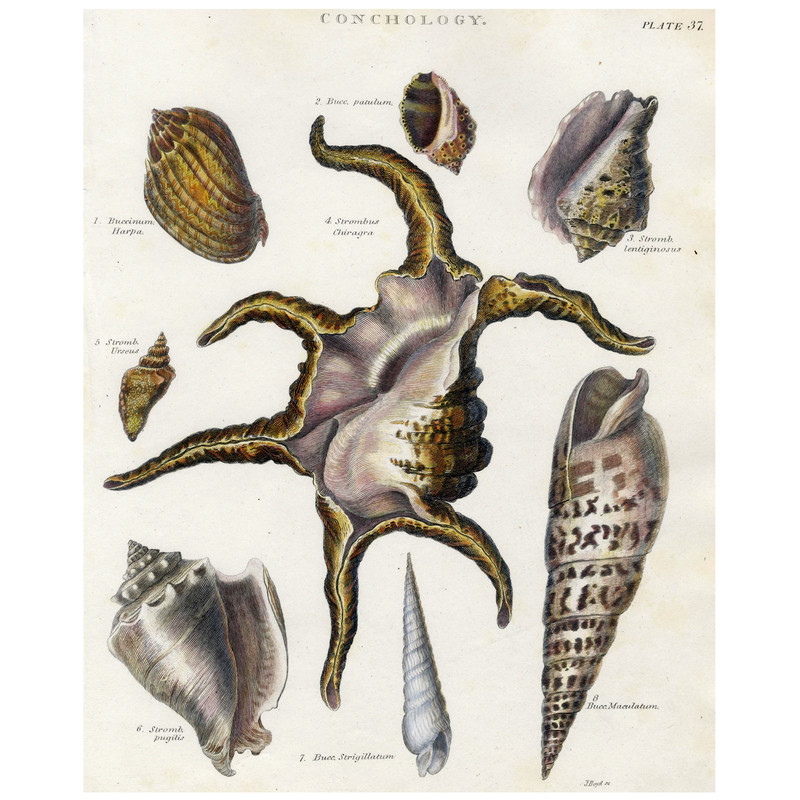RARE 1802 REES CYCLOPAEDIA Hand-Colored Engraving CONCHOLOGY (Seashells) Pl. 37
$ 125.00
1802-1820 Scarce Hand-Colored Copper-Plate Choncology Engraving From:
THE
CYCLOPAEDIA
OR,
UNIVERSAL DICTIONARY
OF
Arts, Sciences, and Literature
By
ABRAHAM REES, D.D. F.R.S. F.L.S. S. Amer.Soc.
CONCHOLOGY.
GENUS MYA_G. MACTRA_G. VENUS_G. MYTILUS_G. DONAX.

This magnificent, large hand-colored engraving originates from Rees's Cyclopædia, produced serially between 1802 and 1820, which contained some of the most detailed & exceptional engravings of the few important encyclopedias of the age.
It's extremely rare to find any of these plates which are hand-colored, as the original plates were issued un-colored. To have a set custom hand-colored at the time (or even a later professional job) would have been an exorbitant expense. The coloring in this one is beautifully detailed, both bold & subtle, & dexpertly done.
The composition, drawing & detailed line-engraving are quite stunning. The meticulously detailed hand water-coloring appears to be as bright as the day it was painted. Many of these extremely rare plates from this work are among the best botanical line-engravings I've seen & collected.
The Volumes:
Rees's Cyclopædia, in full The Cyclopædia; or, Universal Dictionary of Arts, Sciences, and Literature, was an important early 19th-century British encyclopaedia edited by Rev. Abraham Rees (1743–1825), a Presbyterian minister and scholar who had edited previous editions of Chambers's Cyclopædia.
The Cyclopædia appeared serially between January 1802 and August 1820, and ran to 39 volumes of text and 6 volumes of plates including an atlas. It contains around 39 million words, and around 500 of the articles are of monograph length. The sheets were produced weekly, and issued as half-volume sets several times a year.
Rees's Cyclopædia was printed by Andrew Strahan, the King's Printer. It was entirely hand-set (there being no mechanical means of composition at this date) and printed. At the commencement of the work Strahan had nine wooden presses and over 20,000 kg of type. By 1809 this had risen to fifteen wooden presses and 36,000 kg (79,000 lb) of type.[10] Since the Cyclopædia was produced serially, with a few sheets being printed each week, only a small part of Strahan's men and equipment would have ever been used on it at any one time. The work was printed on demy paper and folded to quarto format, with an uncropped size of 11+1⁄4 by 8+3⁄4 inches.
The publication of Rees followed the common system of a number of booksellers banding together to share the cost and eventual profit: the conger (syndicate). The syndicate comprised Longman, Hurst, Rees, Orme, & Brown, Paternoster Row; F. C. and J. Rivington, publisher to the SPCK (publishers of the British Critic); A. Strahan, King's Printer; and 24 smaller concerns. The full list is on the work's title page.
No records of the publication survive, since the papers of Longmans were destroyed when their premises in Paternoster Row, London, were burnt out in the Blitz on the night of 29–30 December 1940.
The Author & Editor:
Abraham Rees (1743 – 9 June 1825) was a Welsh nonconformist minister, and compiler of Rees's Cyclopædia (in 45 volumes).
Rees's work as a cyclopædist began as an improver of the Cyclopædia of Ephraim Chambers, originally published in 1728, in 2 volumes. This was re-edited by Rees in 1778; and, with the incorporation of a supplement and much new matter, was issued by him in 1781–6, in 4 volumes; reprinted 1788–91. In recognition of his labour he was elected in 1786 a Fellow of the Royal Society, and subsequently of the Linnean Society.
The Artists:
Among the artists and engravers employed were Aaron Arrowsmith (1750–1823) who engraved the maps; William Blake (1757–1827) who made engravings to illustrate some of the sculpture articles; Thomas Milton (1743–1827) who engraved most of the natural history plates; Wilson Lowry (1762–1824) who engraved numerous of the plates especially those relating to architecture, machinery and scientific instruments.
Sydenham Teast Edwards (5 August 1768 – 8 February 1819) made many of the Natural History drawings. Edwards had a precocious talent for draughtsmanship and when only 11 years old had copied plates from Flora Londinensis for his own enjoyment. Edwards produced plates at a prodigious rate: between 1787 and 1815 he produced over 1,700 watercolours for the Botanical Magazine alone. He illustrated Cynographia Britannica (1800) (an encyclopaedic compendium of dog breeds in Britain), New Botanic Garden (1805-7), New Flora Britannica (1812), and The Botanical Register (1815-19). Edwards established the latter under his own editorship in 1815 after a disagreement with John Sims, who succeeded Curtis as editor. He also provided drawings for encyclopedias such as Pantologia and Rees's Cyclopædia. He completed a number of parrot illustrations between 1810 and 1812 which were acquired by Edward Smith-Stanley, 13th Earl of Derby. Edwards was elected a Fellow of the Linnean Society in 1804.
Condition:
Appears to be in excellent condition for a centuries-old engraving, The hand-coloring appears sharp & brilliant. The quality of the work is superb. Some antiquarian character as is almost always the case with antiquarian prints. Please peruse the detailed photos. These prints are very old & may have minor imperfections expected with age, such as some typical age-toning of the paper, oxidation of the old original watercolors, spots, text-offsetting, artifacts from having been bound into a book, etc. Please examine the photos & details carefully.
Text Page(s): This one comes without original text page(s). I've included a scan of a title page from one of the related volumes for reference, it's not part of this listing.
Size: 11 x 8-1/2" Inches approximately










